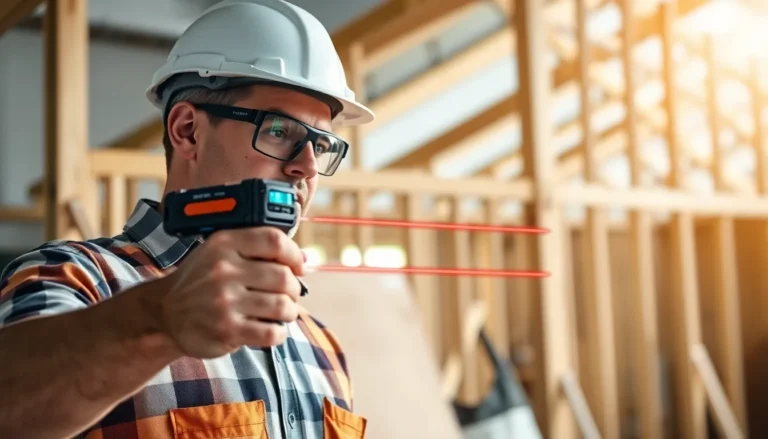Table of Contents
ToggleImagine walking into your home, and it greets you like an old friend—lights flicker on, your favorite playlist fills the air, and the thermostat knows just how you like it. Welcome to 2024, where smart home tech isn’t just a luxury; it’s practically a necessity. As gadgets get smarter, they’re transforming everyday living into a seamless experience that even your grandma would approve of.
Overview of Smart Home Tech 2024
Smart home technology in 2024 integrates seamlessly into daily life, transforming homes into highly responsive environments. With advancements in artificial intelligence, devices now interpret user preferences with remarkable accuracy. Many homeowners enjoy features like automated lighting, climate control, and security systems that adjust based on real-time data.
Energy efficiency remains a top priority. Smart thermostats optimize heating and cooling by learning usage patterns, which can lead to a reduction in energy costs by 20% or more. Additionally, smart appliances contribute to sustainability efforts; dishwashers and washing machines now use less water and energy while enhancing performance.
Voice assistance has evolved, providing more intuitive control. Smart speakers facilitate commands not just for music and entertainment, but also for home management tasks like grocery ordering and calendar scheduling. This technology streamlines routines, enhancing convenience for busy households.
Healthcare integration displays significant growth. Wearable devices can sync with home networks, allowing real-time health monitoring. Alerts can be sent to caregivers or family members when anomalies occur, greatly benefiting elderly residents.
Security is more robust in 2024. Advanced cameras and smart locks offer remote monitoring and control, enhancing peace of mind for homeowners. Many systems include facial recognition features, enabling personalized access for family and friends while keeping unwanted visitors out.
Overall, smart home tech in 2024 prioritizes convenience, efficiency, and security. It empowers users to customize their living spaces while promoting sustainability, creating a more enjoyable lifestyle for residents of all ages.
Latest Trends in Smart Home Technology
Smart home technology in 2024 embraces several exciting trends. These innovations focus on personalization, efficiency, and enhanced security, elevating everyday living.
AI Integration in Smart Devices
Smart devices now rely heavily on AI for improved functionality. With AI algorithms analyzing user behavior, devices adapt lighting and climate preferences automatically. User interactions with devices become more intuitive as AI understanding deepens. Manufacturers release smart assistants that coordinate tasks seamlessly, from adjusting thermostat settings to managing household schedules. Increasingly, smart appliances employ AI to optimize energy usage, contributing to overall sustainability, and reducing utility costs by over 20%.
Enhanced Security Features
Smart home technology prioritizes security enhancements in 2024. Advanced camera systems provide high-definition surveillance with smart alerts for unusual activity. Users access real-time video feeds remotely, ensuring peace of mind from anywhere. Smart locks employ fingerprint and facial recognition for secure entry, making traditional keys obsolete. Home security becomes smarter with AI-powered analytics, quickly evaluating potential threats and notifying homeowners. Enhanced detection capabilities and user-friendly alerts make protecting homes simpler and more effective.
Popular Smart Home Devices of 2024
Smart home devices continue to evolve, offering new functionalities that enhance daily life. Here are some of the most popular devices in 2024.
Smart Speakers and Displays
Smart speakers and displays dominate the market in 2024. Users rely on these devices for voice commands, controlling music, lighting, and even household appliances. Voice assistants now perform tasks like grocery ordering and calendar management, streamlining daily routines. Integration with other smart home systems allows for cohesion among devices, enhancing user experience. Many models feature high-quality displays that show video feeds and provide visual information, combining functionality with entertainment. Enhanced privacy controls offer users peace of mind while using these devices.
Smart Lighting Solutions
Smart lighting solutions transform home environments in 2024. Color-changing bulbs provide ambiance, adjusting to different times of day and user preferences. Many devices now offer automation features, allowing lights to operate based on movement or time schedules. Energy efficiency remains a top priority, with some smart bulbs consuming up to 80% less energy than traditional ones. Users benefit from remote control access, setting the mood from anywhere. Advanced lighting systems can even synchronize with music or movies, creating immersive experiences.
Benefits of Adopting Smart Home Tech
Adopting smart home technology enhances overall convenience significantly. Personalized environments adjust lighting, music, and temperature to fit user preferences instantly. Homes become highly responsive, which contributes to a better quality of life for residents.
Energy efficiency stands out as another major benefit. Smart thermostats optimize conditions, reducing heating and cooling costs by 20% or more. Additionally, smart appliances utilize less water and energy, reinforcing sustainability goals.
Enhanced security features provide peace of mind. Advanced cameras and smart locks enable remote monitoring, allowing homeowners to oversee their properties in real time. Facial recognition technology personalizes access, further improving safety.
Health monitoring becomes seamless with smart home integration. Wearable devices sync with home networks, offering real-time updates on health metrics. This feature particularly benefits elderly residents, ensuring their well-being is closely monitored.
Voice assistance has advanced, streamlining home management. Users can control tasks like grocery ordering and calendar scheduling effortlessly. The intuitive nature of these systems simplifies daily routines, promoting a more organized lifestyle.
Customization options abound with smart home technology. Residents can tailor settings for lighting and climate based on individual preferences, ensuring a comfortable living space. Algorithms analyze user behavior, continually enhancing the smart experience.
Convenience extends to entertainment systems as well. Smart speakers and displays allow for easy control of music and video content. The integration of these devices into everyday activities leads to better engagement and enjoyment.
Adopting smart home tech now offers numerous advantages. Prioritizing energy efficiency, convenience, and security leads to improved daily living conditions. Overall, embracing this technology results in a more enjoyable and secure home environment for everyone.
Challenges and Considerations
Adopting smart home technology in 2024 presents several challenges and considerations for users. Security concerns stand out, as interconnected devices may be vulnerable to hacking. Cybersecurity threats increase as more devices connect to home networks, necessitating robust security measures.
Privacy issues also arise with the data collection habits of smart devices. Homeowners often face challenges regarding transparency, as manufacturers may not fully disclose data usage policies. Users must evaluate these terms carefully to protect their personal information.
Integration compatibility poses a significant obstacle. Many households host devices from various brands, leading to potential communication breakdowns. Ensuring that devices work harmoniously requires selecting compatible systems or investing in hubs for seamless synchronization.
Cost factors contribute to the decision-making process as well. Initial investments for advanced devices and installation can be substantial. Homeowners should assess long-term savings against upfront expenses to determine the overall value of smart home tech.
User adoption remains critical in overcoming challenges. Some individuals resist transitioning to smart technology due to familiarity with traditional methods. Education and demonstrations of convenience often help alleviate skepticism and encourage the adoption of smart devices.
Regulatory compliance issues can complicate the smart home landscape. Local laws regarding data protection and device usage vary significantly. Homeowners need to stay informed on regulations to ensure their smart systems operate within legal frameworks.
Sustainability considerations are increasingly relevant. Although smart devices can enhance energy efficiency, their production and eventual disposal have environmental impacts. Evaluating these factors helps consumers make informed choices aligned with sustainability goals.
Smart home technology in 2024 is reshaping the way people live by creating environments that are not only responsive but also personalized. As homes become smarter and more efficient the benefits extend beyond convenience to include energy savings and enhanced security.
With advanced AI and intuitive devices residents can enjoy seamless control over their living spaces while also ensuring their well-being through integrated health monitoring.
While challenges like security concerns and integration compatibility exist the advantages of adopting smart home tech far outweigh the drawbacks. Embracing these innovations leads to a more enjoyable and sustainable lifestyle making it an essential consideration for modern homeowners.







